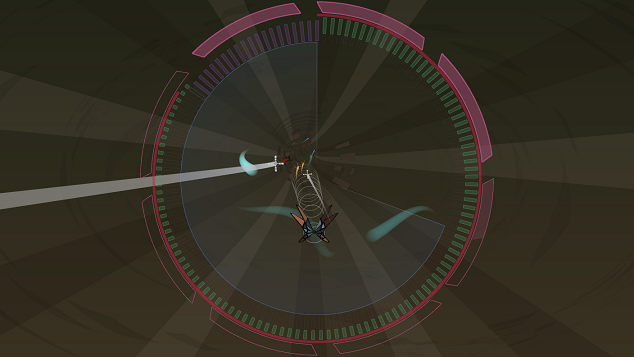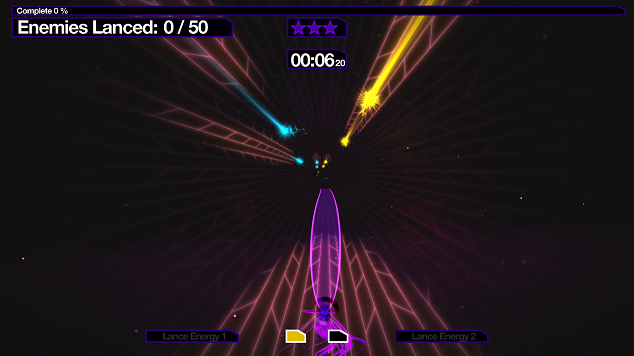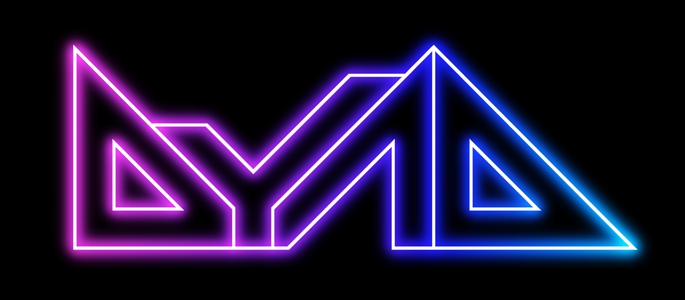In this exclusive interview, Shawn McGrath gives PlayStation LifeStyle a unique perspective in game development. Having created Dyad almost completely by himself from beginning to end, we discuss the trials and tribulations that are rarely talked about in modern game development.
Dan: With having some of the most unique visuals I have seen in a PSN release title, what was your inspiration for Dyad? Some of the levels look like an acid trip, was this a goal from the beginning, or was it a result of one too many sleepless nights?
Shawn: When I first started I really had no idea what the graphics were going to look like. There were certain constraints: I’m good with Photoshop, code and color and not much else! So 3D models and that kinda stuff was out of the question. Developing a “proper” 3D engine like what modern AAA games use was out of the question too, so I just worked with what tools and skills I had. The early versions were horrible… here’s a screenshot of what it looked like early on, haha actually I don’t think it’s that horrible :).
 PSLS Exclusive Screenshot of an early build of Dyad
PSLS Exclusive Screenshot of an early build of Dyad
Game design was also a *HUGE* constraint on the visuals. The graphics had to convey a sense of speed while not being overwhelming. Dyad feels extremely fast… a lot of that is graphical trickery. Most levels visually are a tube inside of another tube, which allows us to move one tube really fast and another pretty slow and it’ll make it feel really fast… also the smaller inside tube creates a claustrophobic feel which makes things feel faster as well. I spent a lot of time trying to understand “real” speed VS “perceived” speed.
A couple tricks were done to make the game actually playable too. Even though a good part of the speed is just an optical illusion, it still is a fast game. There’s a lot of things that guide your eye towards what’s important. For example the inner tube gets highlighted long before enemies are anywhere near you and most enemies have a trail before them so you have more time to react, (there’s a bunch of interaction nuances that make the game playable at high speed too that I won’t get into here). Here’s a look at one of the levels with all it’s optical tricks to make it appear fast, and still be playable:
 PSLS Exclusive Screenshot
PSLS Exclusive Screenshot
Once all these constraints were figured out, (I didn’t list all of them, it took years to figure it all out), there was a pretty narrow space with what we could do visually. Color is the most obvious thing people notice and differentiate objects with, so the colors were very carefully selected. Enemies are usually 180, or 120 degrees apart with very similar saturation and brightness. The backgrounds are usually much less saturated. All interaction event graphics: explosions, hook indications, immunity indications, energy collections, etc needed to be distinctive, not occlude important information areas, (unless designed to), and animate extremely quickly. The interaction density is so high that slow animations will clutter the screen very quickly — try playing the game in “Remix Mode” and use the L2 trigger to slow the game down to really see all the animation details. There’s not a whole lot of room to maneuver with these constraints, so working out the graphics was mostly a fight with the game and less of a visual expression. Towards the end of the game, when players are better trained to interpret the screen more efficiently, the graphics begin to break these rules for very interesting effects, but even figuring how to effectively break these rules was difficult.
How was the idea behind keeping things in pairs (a Dyad) developed? Did the name come first, or did things naturally just fit in pairs? Was this ever a limiting factor in the design process?
The idea was first noticed as we started stripping things out of the game. About a year into development, the game had more interactions than it does now — way more. There was some rhythm mechanics, (hitting a button when you ran over certain objects), a few shooting weapons, hook was called “vampire” because it constantly leeched speed from enemies, and you tried to pass enemies, (it was much more of a ‘racing’ game then). Lance existed, but it was quite a bit different – it was more opportunistic and less skillful… anyway we studied all these mechanics to look for overlaps to make the interaction model as elegant as possible: we wanted to increase the strategic potential and depth of play while removing as many things as possible; fewer, more nuanced mechanics was the goal. As we analyzed the mechanics it quickly became clear that striking a balance between positive and negative effects of each interaction would create more variance and depth in how you made choices when you played… then using these deep choices allowed for more enemy-based mechanics and nuance as opposed to control based ones, which made the game much more interesting. I think the reason for this was balance: instead of offloading all the nuance to the controller we used the entire play-space as evenly as possible.
This good/bad balance led to a 2 button interaction system: Hook and Lance, it also led to a 2 enemy polarity system. 2 polarities gave a constantly changing value assignment for each enemy — one that the player has control over. We tried a 3 chain system straight of Ikaruga and that quickly evolved to a 2 chain system or “pair” as it’s called in game… the pair was MUCH better than 3 because it allowed for the value of interactable objects to change at a much faster rate, giving you more control of the whole play-field. At this time you could store up 8 lances, we tried 2, much better: it shortened the collect/spend cycle which fit into the whole “really fucking fast game” theme… everything worked better in pairs.
I don’t remember at which point we decided on the name ‘Dyad‘ – but it was somewhere in there… we were also reading a lot of esoteric pseudo science and philosophy trying to think of fiction ideas to make Dyad feel like it was happening in a “real” place. We read about monadology, Leibniz’s metaphysical philosophy. It sounded nice, and was kinda a fun way to think about things. We took the root word “monad” in Greek, which means something like “god or divinity” and increased it to “Dyad” — something beyond that!
I have heard Dyad called a “Tunnel Racing Puzzle Shooter”, but what exactly sets it apart from other “tube shooters” like Tempest, Amplitude, or Audio Surf?
It’s different in every conceivable way except the fact that it takes place in a tunnel :).
The interactions are completely new and don’t exist elsewhere as far as I know… at least in this form. Some were taken and re-purposed from other games: the polarity system was adapted from Ikaruga however the end result is much different, but Ikaruga was a very good starting point. The grazing mechanic came out of Psyvariar, (although it was called “BUZZ” in Psyvariar). I looked at grazing in Radiant Silvergun too, but it was pretty inconsequential except for super high level score runs. At one point I copied verbatim mechanics from Internal Section, N2O and Torus Trooper. I spent a lot of time playing with those mechanics to see what worked and what didn’t. Nothing from those games made it directly into the game, but everything I learned from copying and dissecting those games made it in, if not consciously then at least subconsciously.
The weapon design was inspired by partially by Radiant Silvergun, or at least what I envision Radiant Silvergun’s weapon design strived to be. The “weapons” (“weapon” isn’t a good word because that implies murder or something, and they’re much more nuanced than just killing tools in Dyad), are completely orthogonal. There’s a very big grey area as to which you should be using at a certain time despite their orthogonally. In addition, the “best” weapon for the current situation changes rapidly.
The bulk of the depth comes from very few elements that are highly nuanced, unlike most games that could be called superficially similar.
In terms of presentation, I think it’s pretty clear how Dyad’s different :).
Is there any form of story piecing Dyad together, or is it just an experience?
There’s a story in a way that I think video games should tell a story… if that makes any sense :). There’s no text or anything other than some mechanical explanations. I think the interactions and a few hints here and there lead you on a path create your own story. I think every player’s story will be different, which makes sense given the medium is interactive — shouldn’t the narrative meaning be interactive as well?… not literally? Does that make sense? Probably not.
Regarding “experience” — Dyad didn’t become a compelling “experience” until about 3 years into development. Most of the effort on the game was spent on mechanic, level, interaction and enemy design…the presentation “experience” just ties all that stuff together.
What was the decision process for developing the music? Some of it seems to hearken back to an 8-Bit era, is that intentional?
You’ll have to ask David about that. I don’t think there’s anything 8-bit about the music, although I’m having trouble parsing what you mean by “8-bit” 🙂 I think David approached the music in a similar way to how I approached the story. There’s no linear music in the game, it’s all created based on how you’re playing. It’s kind of like a more evolved Space Invaders maybe? Seriously Space Invaders has amazing music design!
As Dyad seems to build upon itself with each level; do you worry that the later levels will be too difficult for some players? If so, how was this addressed?
I’m not worried that they’re too difficult — I know for a fact they aren’t 😉 I constantly play tested Dyad for the entire four years of development. The game is structured in the most optimal way I could find to show players radically new, interesting mechanics while still being coherent. This may sound like an obvious thing for games, but it was a lot of work :). Some levels you might have to replay once or twice, but that’s okay I think, they’re short! Each level adds something new, so you’re constantly learning. I didn’t want to bore people by making them do the same thing repeatedly, so I kept the game as short as possible and as dense as possible… I think the learning curve is pretty good!
The last time we spoke at E3, I was given a postcard of one of the later levels. Any chance I can get you to tell shed some light on the chaos?
 Confused? Cause I am
Confused? Cause I am
Nope! You’ll understand it when you get there 🙂
With Dyad’s release right around the corner, have you given thought to what you are going to work on next? Any plans for DLC? Will you be taking a break, or going straight into the next project?
I’m going to do some DLC stuff… no more levels though. Dyad is a complete package from beginning to end, and I have nothing else to say with its design. That may not be true in 6 months, but it’s true now. I’ve already started on some tech for the next game, and I’m going to do some DLC toys for Dyad to test out some of the ideas I want to try for my next game — David’s working with me on that too.
Have you decided if you are going to bring on more staff for future titles? Will the next thing we see from ][ Games be another PSN release?
I’m not sure about more staff. I like being in control of everything, and I think it’s wrong to make other people deal with my borderline insanity when it comes to my work. I’ve thrown away… I dunno, millions of lines of code? If I was working with someone else I’d feel terrible telling them everything they did for the last two years has to go.
Also, I don’t know how to describe what I want from a game in words… so it’s very difficult for me to work with people. I’m definitely going to work with David again though, I think he has very similar values to mine, and we don’t have much skill overlap so there’s not much “lost in translation.” I’d like to work with Pekko, (original co-designer), again… I’ll never understand where he gets his ideas 🙂
For those of you who are curious to try out Shawn McGrath’s latest game – Dyad, you are in for a treat. PlayStation LifeStyle will be giving away 5 copies over the next few days. The first code will be given away to a lucky fan here, all you have to do to win is post below letting us know your thoughts on how indie development will fare on next-gen consoles.
The lucky winner will be announced on the same day Dyad is released on July 17th. So stay tuned to PSLS and follow me on Twitter @Foolsjoker for more news from PSLS.
[UPDATE] And the winner is: Vesra.








